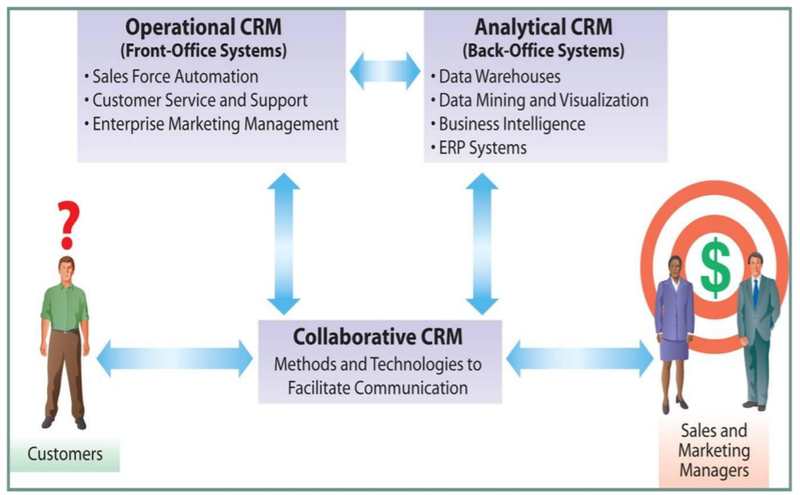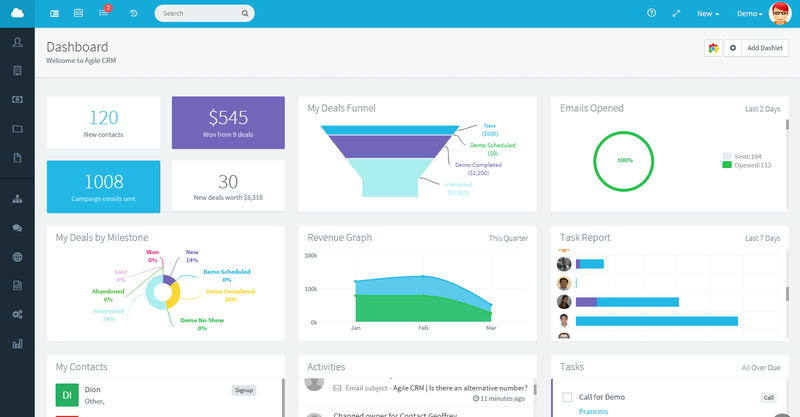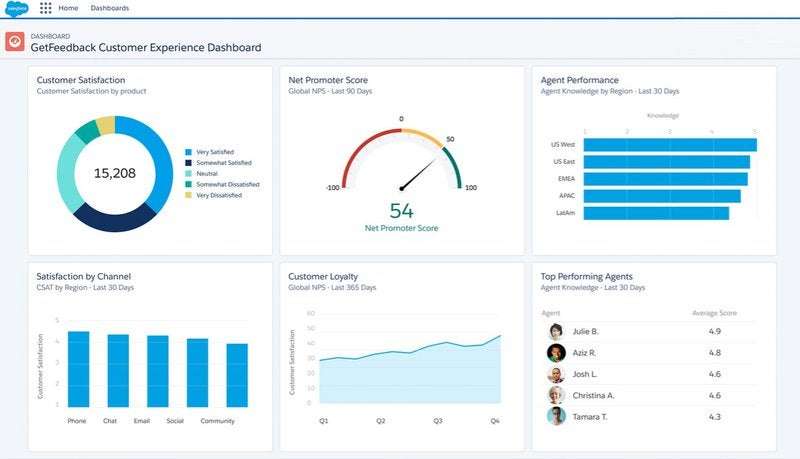Relationship management is integral to every business. From nurturing sales leads to providing after-sales support, your small business continually generates valuable information about your customers and your interactions with them.
It’s what you do with it that makes all the difference.
Analytical customer relationship management (CRM) applications use this data to create reports that make your marketing, sales, and customer service more effective. We’ll go over analytical CRM basics, how it functions within your business, and case studies that show its real-world benefits.
Overview: What is analytical CRM?
Analytical CRM is one of three primary CRM types — the other two are operational and collaborative — and works behind the scenes to crunch your business data. Analytical CRM reports provide actionable insights to grow your customer base, increase sales, and improve customer service.
Analytical, operational, and collaborative CRM benefits are not mutually exclusive. Instead, these different types work together across multiple business areas to help you achieve business objectives.
Operational and collaborative CRMs perform front-line business activities, while analytical CRM “thinks” about the resulting data collected.

Generalized CRM applications may include analytical, operational, and collaborative tools. Or, you can use different CRMs focused on one area to provide more granular functionality.
Functions of an analytical CRM
Your CRM aggregates data from multiple sources: customer interactions, omnichannel communications, marketing campaigns, deals, and more. An analytical CRM uses three tools — a data warehouse, data mining, and online analytical processing (OLAP) — to analyze this information.
CRM analysis produces reports about multiple business areas:
• Marketing: Examine marketing campaign metrics — including opens, click-throughs, forwards, and channel performance — and customer characteristics interacting with campaigns and your website.
• Sales: Measure sales activities such as lead conversion, sales growth, product performance, and new versus repeat business.
• Customer service: Calculate customer satisfaction rates, agent response times, average time to resolve issues, and self-service resources usage.
These reports, interesting as they are, aren’t an end unto themselves. Rather, they help shape strategies affecting all aspects of your business.
Marketing reports
Before digital marketing, advertising performance was difficult to gauge. Sure, you knew a newspaper’s circulation where your ad ran or how many addresses were on a direct mail list, but you had no way to measure the revenue impact, or return on investment (ROI) of marketing pieces.
Analytical CRM solves that and gives you information for multiple marketing data points. Tableau Software’s return on ad spend by segment report provides a deep dive into marketing ROI.
• Customer acquisition cost (CAC) by quarter
• Customer lifetime value (LTV) by quarter
• Sources of new customers
• Customer devices used
Tableau’s right-hand list of checkboxes lets you filter reports by browser, operating system, gender, age range, and country. The report below, for example, is about Canadian women from ages 33-45.

If you use buyer personas — detailed descriptions of your ideal customers — analytical CRM marketing reports provide key information about your efforts to reach these target consumers.
Sales reports
Sales are the lifeblood of your business, and while in-depth financial reports have long been available, data about sales teams and individual performance was less transparent.
Sure, “buy low, sell high” and “second prize is a set of steak knives, third prize is you’re fired” are common sales pit maxims, but you need to learn more about how and why top sellers are outperforming those left wanting. You can use that information to help lower producers improve their performance.
The Agile CRM sales dashboard provides sales reps and their managers with need-to-know performance data:
• Value of new deals
• Sales funnel statistics
• Deals by milestone
• Revenue graph
Nobody should go blind deciphering endless rows of spreadsheet cells, so data visualization is critical. Agile CRM’s dashboard uses multiple colors and chart styles to convey different sales information.

Sales performance isn’t a matter of some people having “it” and others not. Inherent talent is helpful, but the drive to do better is more important.
Analytical CRM sales reports show where people are doing well and what needs improvement, so employ targeted training — perhaps the finer points of prospecting or lead management — to improve outcomes.
Customer satisfaction reports
Traditionally, sales were considered transactional because each purchase was a unique, short-term event. Relational selling, however, is less about one transaction and more about building a long-term relationship to maximize customer lifetime value.
This change in perspective makes your customer service before, during, and after sales critically important.
The Salesforce CRM customer experience dashboard includes:
• Customer satisfaction by product and channel
• Customer loyalty
• Help agent performance by region
• Top-performing help agents
The top-level customer experience report below provides a global performance overview. You can also examine these areas more closely to identify underlying trends.

Quality customer experience boosts retention rates. While customer acquisition is a priority for every company, retention has an outsized impact on revenue generation. New customers cost five times more to acquire than retaining current ones, and a 5% retention rate improvement can increase revenue up to 95%.
How an analytical CRM works within a small business
The CRM examples above showed how data analytics reporting applies to marketing, sales, and customer satisfaction. Now, let’s look at three real-world examples of CRM analysis to demonstrate its financial benefits.
1. Marketing with an analytical CRM
Founded in 1985, Satami makes fitted lingerie for women. The company couldn’t effectively measure its ROI from search engine marketing (SEM), social media, and other online channels.
Satami partnered with XGATE to implement analytical CRM to track marketing results across digital campaigns and increase customer lifetime value. It now uses near real-time performance metrics, which has grown new leads by 7% with related growth in sales conversions.
2. Sales with an analytical CRM
Skyfi Education Labs provides free and paid courses to 250,000 students in 30 countries. In 2019, analytics reports showed its lead conversion rate — the number of students using free classes who subsequently bought access to more courses — was far below industry standards.
Skyfi added a chatbot feature to its website to improve sales, and in five months, twice as many website visitors became paying customers.
3. Customer service with an analytical CRM
Knology is a bundled video, voice, and data communications service provider in the southeastern U.S. The company’s nine divisions had different customer service procedures, provided no online support documentation, and used spreadsheets for manual scheduling.
Knology chose Verint System’s Impact 360 software to unify customer support operations. The resulting performance analytics showed an increase in first call resolution from 63% to 82% and a $1 million annual decrease in call center costs.
Benefits of using an analytical CRM for your small business
On its own, analytical CRM doesn’t “do” anything in the way a collaborative or operational CRM does. The analytical tools it employs, however, give you information that allows you to make informed decisions for your small business and streamline the front-line activities of your other CRM applications.
1. Marketing campaign analysis
Marketing is no longer a black hole to throw money into while you wonder about its net positive effect. Tracking digital marketing performance — everything from recipient demographics to customer acquisition cost to your reach across channels — allows you to better design future campaigns.
2. Sales and service optimization
Making your sales and service operations more efficient has a direct bottom-line impact. Know exactly where your lead nurturing and sales funnels are working well and what needs improvement. Provide better customer service to retain your current client base and create cross-selling and upselling opportunities.
3. Financial planning and forecasting
Sales analytics not only tell you where your sales were and are now, but it can forecast where they’re going. Beyond projecting overall sales based on comparable time periods, further refine these figures through forecasting by sales funnel, lead score, and regression analysis.
Use analytical CRM to leverage your data
Jonathan Swift wrote, “Vision is the art of seeing what is invisible to others.” In the business world, analyzing your data allows you to discover what otherwise could remain hidden. Find the best CRM software for your small business to make that information work for you.
The post A Small Business Guide to Analytical CRM appeared first on the blueprint and is written by Mark Roy Long
Original source: the blueprint






